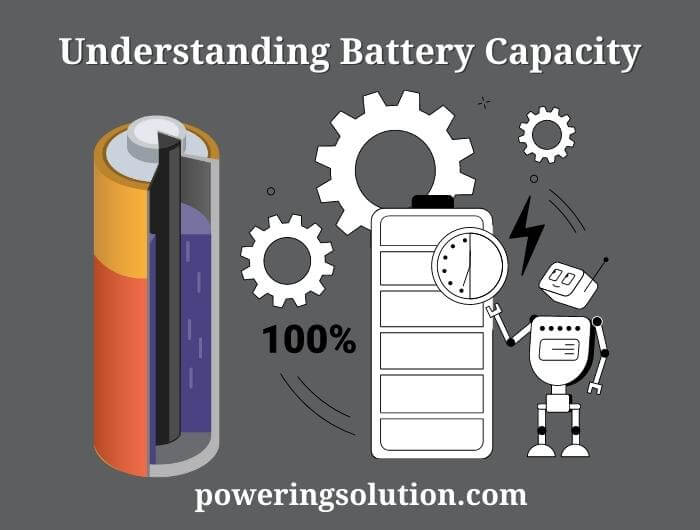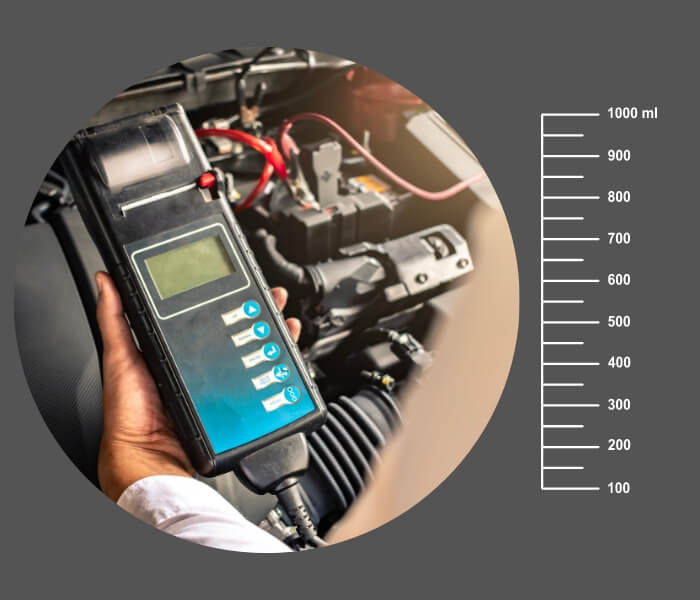Battery capacity is a crucial aspect of modern technology, impacting everything from smartphones to electric vehicles. With the increasing demand for energy-efficient devices, it’s essential to understand what battery capacity means and how it affects your devices. In this write-up, we’ll provide a full blog post article about battery capacity in detail, answering all your questions along the way.

What is Battery Capacity?
Battery capacity measures the amount of energy a battery can store and release before it needs to be recharged. It is an essential factor to consider when evaluating the performance of a device, as it determines how long the device can run on a single charge. The battery capacity is expressed in units of milliampere-hours (mAh) or ampere-hours (Ah), and it represents the amount of energy that can be drawn from the battery over a specific period of time.
For example, a battery with a capacity of 3,000 mAh can provide 3,000 milliamperes of current for one hour or 1,500 milliamperes for two hours, and so on. The higher the battery capacity, the more energy the battery can store, and the longer the device can run on a single charge. Understanding battery capacity is crucial for evaluating the energy efficiency of different devices and making informed purchasing decisions.
How is Battery Capacity Measured?
Battery capacity is measured through a discharge test, in which the battery is drained of all its energy until it is completely depleted. During the discharge test, the voltage and current of the battery are continuously monitored, and the energy that is drawn from the battery is calculated. The amount of energy that has been drawn from the battery is then divided by the time it took to drain the battery to determine the battery’s capacity.

The discharge test is performed under specific conditions, such as a specific discharge rate, temperature, and end voltage. The discharge rate determines the rate at which the energy is drawn from the battery and is usually expressed in milliamperes per hour (mAh). The temperature of the battery during the discharge test is also critical, as the capacity of the battery can be impacted by extreme temperatures.
It’s worth noting that the actual capacity of a battery in real-world use may be different from the results of a discharge test. This is because the battery’s capacity can be impacted by factors such as the age of the battery, the temperature of the environment, and the way the battery is used. Additionally, manufacturers often use different methods to test battery capacity, so it can be difficult to compare the capacities of different batteries accurately.
Factors that Impact Battery Capacity
There are several factors that can impact the capacity of a battery, including the age of the battery, the temperature, and the way the battery is used.
- Age: As the battery ages, its capacity decreases. This is due to a natural process known as “capacity fade,” in which the battery’s ability to store and release energy decreases over time. The rate of capacity fade can vary depending on the type of battery, how it is used, and the temperature.
- Temperature: Extreme temperatures can also impact the capacity of a battery. High temperatures can cause the battery to degrade more quickly, reducing its overall capacity. On the other hand, low temperatures can reduce the battery’s ability to release energy, leading to decreased capacity.
- Usage: The way in which a battery is used can also impact its capacity. For example, constantly discharging a battery to 0% and recharging it to 100% can reduce its capacity more quickly than charging it to a moderate level, between 20% and 80%. Additionally, leaving a battery in a discharged state for an extended period can lead to capacity loss.
- Battery Chemistry: The type of battery chemistry can also impact capacity. For example, Lithium-ion batteries are commonly used in consumer electronics due to their high energy density, which results in a relatively high capacity. Other types of batteries, such as lead-acid batteries, have lower energy densities and therefore lower capacities.
It’s essential to understand the factors that impact battery capacity so that you can extend the life of your battery and maintain its capacity over time. Proper usage and storage, as well as choosing devices with high-capacity batteries, can help to ensure that your devices have reliable and long-lasting power.
What is a Good Battery Capacity?
The definition of a “good” battery capacity depends on several factors, including the type of device, its intended use, and personal preferences.
For smartphones, a capacity of around 3,000 to 4,000 mAh is considered to be a good baseline. This will typically provide enough power for a full day of use, although usage patterns and other factors, such as screen brightness and network connectivity, can impact the actual battery life.
For laptops, a capacity of around 50-60 Wh (watt-hours) is considered a good baseline. This will typically provide enough power for several hours of use, although the actual battery life will depend on the device’s specifications, such as its screen size, processing power, and graphics capabilities.
For wearable devices, such as smartwatches, a capacity of around 300 to 500 mAh is considered a good baseline. This will typically provide enough power for several days of use, although the actual battery life will depend on factors such as the device’s features and usage patterns.
Ultimately, what constitutes a good battery capacity will depend on the specific needs and preferences of the user. It’s important to carefully consider the intended use of a device and choose a model with a battery capacity that meets your needs.
Choosing the Right Battery Capacity
When choosing a device with the right battery capacity, there are several factors to consider.
- Intended Use: The first factor to consider is the intended use of the device. If you need a device that you can use for an extended period without recharging, then a higher battery capacity is typically recommended. On the other hand, if you plan to use the device for short periods or keep it plugged in most of the time, then a lower battery capacity may be acceptable.
- Device Features: The features of the device can also impact its battery life. For example, devices with larger displays, more processing power, and higher-resolution cameras will typically have higher power requirements and therefore need larger batteries.
- Usage Patterns: Your usage patterns will also play a role in determining the right battery capacity. If you plan to use your device frequently and for extended periods, then a larger battery capacity is typically recommended. On the other hand, if you plan to use your device infrequently, then a lower battery capacity may be acceptable.
- Portability: If you need a device that is highly portable, then a lower battery capacity may be acceptable, as smaller and lighter batteries are typically easier to carry. However, if you need a device that you can use for an extended period without access to an outlet, then a higher battery capacity is typically recommended.
- Budget: Finally, budget is also an important factor to consider when choosing a device with the right battery capacity. Devices with larger batteries are typically more expensive, so you’ll need to balance your battery needs against your budget to determine the right balance.
Choosing the right battery capacity for your device requires careful consideration of your intended use, device features, usage patterns, portability, and budget.
By using these factors, you can choose a device with a battery capacity that meets your needs and provides reliable and long-lasting power.
Can Battery Capacity be Increased?
Battery capacity can be increased to some extent, but there are limits to how much it can be improved. Here are some ways to increase battery capacity:
| Use a larger battery | One of the simplest ways to increase battery capacity is to use a larger battery. However, this may result in a larger and heavier device, which may not be ideal for all users. |
| Improve battery technology | Advances in battery technology can also increase battery capacity. For example, the use of newer materials, such as lithium-ion, can result in higher energy density and longer battery life. |
| Optimize software | Software optimizations, such as reducing the number of background processes and reducing screen brightness, can also help increase battery life. |
| Use power-saving modes | Many devices come with built-in power-saving modes that can help extend battery life. These modes typically reduce the device’s processing power, limited connectivity, and dim the display, among other things, to conserve power. |
| Regular battery maintenance | Regular battery maintenance, such as keeping the battery fully charged and avoiding excessive discharge, can also help extend battery life and increase its overall capacity. |
It’s worth noting that there are limits to how much battery capacity can be increased. For example, increasing the size of a battery beyond a certain point will result in a larger and heavier device, which may not be practical for some users. Similarly, advances in battery technology have limits, and there may come a point where further improvements are not possible.
While it’s possible to increase the battery capacity to some extent, there are limits to how much it can be improved. By taking steps to optimize software, use power-saving modes, and perform regular maintenance, you can help ensure that your device has the best battery life possible.
Bottom Line
In conclusion, battery capacity is a critical factor to consider when choosing a device. It determines how long the device can be used without recharging and is influenced by factors such as the device’s features, usage patterns, and battery technology.
By considering these factors and taking steps to optimize battery life, such as using power-saving modes and performing regular maintenance, you can choose a device with a battery capacity that meets your needs and provides reliable and long-lasting power. It’s also important to note that while it’s possible to increase the battery capacity to some extent, there are limits to how much it can be improved.
Ultimately, choosing the right battery capacity requires careful consideration of your needs and a balance between battery life and other factors such as budget, portability, and intended use.
FAQs
What is the Role of Technology in Improving Battery Capacity?
Advances in battery technology, such as the development of new materials and improved charging methods, can lead to higher battery capacity and longer battery life.
How Do I Know if My Battery Has a High Capacity?
You can determine the capacity of your battery by checking its specifications or by conducting a battery test. High-capacity batteries typically have a higher mAh or Wh rating.
